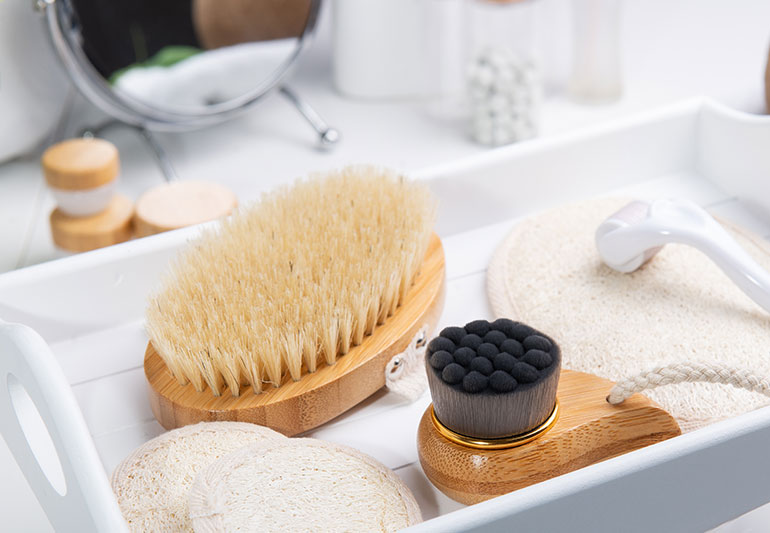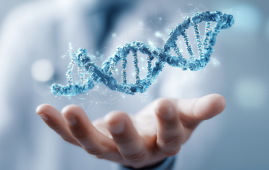

If you’re wondering about the best way to exfoliate and rejuvenate your skin, dry brushing is an option that has many benefits. But it does require some precautions, too. There are a variety of health claims and myths about dry brushing your skin, so it’s important to do it the right way and know when it’s not ideal.
If you’re not sure what dry brushing your skin is, it’s a daily body massage with a dry, stiff-bristled brush that’s said to help flaky winter skin, increase circulation, detoxify, help digestion – and even improve the appearance of cellulite.
But are these claims true?
“Some are true, but definitely not all,” according to dermatologist Shilpi Khetarpal, MD.
Below, find some questions patients often ask Dr. Khetarpal about dry brushing and the best way to do it.
Is dry brushing your skin good or bad?
The mechanical action of dry brushing is excellent for exfoliating dry winter skin, she says. “Dry brushing unclogs pores in the exfoliation process. It also helps detoxify your skin by increasing blood circulation and promoting lymph flow/drainage,” says Dr. Khetarpal.
It can also make you feel good since it has the additional benefit of stimulating your nervous system, which can make you feel invigorated afterward, the way getting a massage often does.
What brush should I use to dry brush?
To get the benefits of dry brushing you’ll want to use a natural stiff-bristled bath or shower brush, preferably one with a long handle. Some bristles are stiffer than others, and it depends on your skin’s sensitivity and preference. The long handle is helpful for tough-to-reach areas like your back.
Can I dry brush with sensitive skin or other skin conditions?
There are reasons for caution on sensitive skin, but it’s possible to use a dry brush if you have sensitive skin.
For dry brushing to be fully effective, the bristles must generally pretty firm — an obstacle for those with sensitive skin. But if your skin is too sensitive, you can try a plain, dry washcloth. This can still provide some benefits but don’t continue if you notice redness, swelling or inflammation.
Dr. Khetarpal also advises to begin dry brushing by looking at the skin on your whole body to identify any places to avoid — like spots where there are bumps or other skin abnormalities of any kind. There are many skin conditions where dry brushing is not recommended.
Never dry brush over moles, warts, or raised bumps, among many other things. See your dermatologist if you have questions.
“Do not use this technique on skin that’s broken, which includes cuts, scrapes, lesions, sores or burned skin, including sunburns,” she adds. “Don’t ever brush over areas of infection, redness or general irritation, inflammation, cellulitis or skin cancer. Stop dry brushing if skin becomes irritated or inflamed.”
Dr. Khetarpal also points out to avoid using a dry brush on your face since the skin is more sensitive than on the rest of your body. “If you want to exfoliate your face, use more gentle products and methods that are designed for specifically for it,” she says.
When should I dry brush?
The best time to dry brush is just before a shower. Then you can wash off any dead skin cells and flaky skin. Be sure to apply lotion afterward to put moisture back into your skin.
Why not exfoliate in a hot shower?
Hot water inflames your skin and even strips away oils, fats, and proteins that keep skin healthy. This can cause redness and itching.
Brushing the skin while it is dry allows you to exfoliate and increase blood circulation without robbing it of moisture the way the hot water in your shower can.
How do I dry brush my skin?
“Using a natural bristled brush,” Dr. Khetarpal says. “I typically start from my feet or ankles and work my way upward in long, fluid strokes on limbs. Then I’ll focus on circular motions on my torso and back.”
She says this process can be sensitive on your abdomen, breasts and neck, so lighten up pressure as needed.
“A few overlapping swipes per area is enough,” she adds. “If you go over one area too long, you can actually break the integrity of the skin and cause irritation or bleeding.
Do this once each day and shower immediately afterward.
Can dry brushing get rid of cellulite?
There is no proof dry brushing your skin reduces cellulite or the appearance of cellulite — this claim isn’t supported by any scientific evidence.
“It’s likely that what people interpret as cellulite reduction is really just a temporary plumping up of the skin from increased blood circulation,” Dr. Khetarpal says.
“Remember, make sure you begin the process by getting to know your skin first and giving it a look to see if there are any areas to avoid,” she emphasizes. “If you notice any concerning changes in your skin make an appointment with your dermatologist, especially before you begin any change in your skincare routine.”
more recommended stories
 Can Ketogenic Diets Help PCOS? Meta-Analysis Insights
Can Ketogenic Diets Help PCOS? Meta-Analysis InsightsKey Takeaways (Quick Summary) A Clinical.
 Ancient HHV-6 Genomes Confirm Iron Age Viral Integration
Ancient HHV-6 Genomes Confirm Iron Age Viral IntegrationKey Takeaways for HCPs Scientists reconstructed.
 Fat-Regulating Enzyme Offers New Target for Obesity
Fat-Regulating Enzyme Offers New Target for ObesityKey Highlights (Quick Summary) Researchers identified.
 Gestational Diabetes Risk Identified by Blood Metabolites
Gestational Diabetes Risk Identified by Blood MetabolitesKey Takeaways (Quick Summary for Clinicians).
 Pelvic Floor Disorders: Treatable Yet Often Ignored
Pelvic Floor Disorders: Treatable Yet Often IgnoredKey Takeaways (Quick Summary) Pelvic floor.
 Circadian Control of Neutrophils in Myocardial Infarction
Circadian Control of Neutrophils in Myocardial InfarctionKey Takeaways for HCPs Neutrophil activity.
 E-Cigarette Use and Heart Attack Risk in Former Smokers
E-Cigarette Use and Heart Attack Risk in Former SmokersKey Takeaways for Clinicians and Nurses.
 Ultramarathon Physiology: What HCPs Should Know?
Ultramarathon Physiology: What HCPs Should Know?Ultramarathon Metabolism: What Happens to the.
 High-Intensity Training and Oxidative Stress Insights
High-Intensity Training and Oxidative Stress InsightsNew Evidence Linking High-Intensity Training and.
 Sterilized Fermented Beverage for Obesity: New Evidence
Sterilized Fermented Beverage for Obesity: New EvidenceEarly Insights Into a Sterilized Fermented.

Leave a Comment